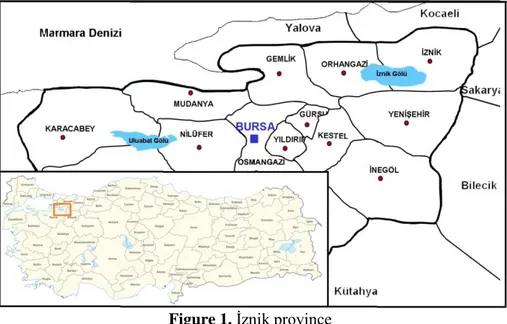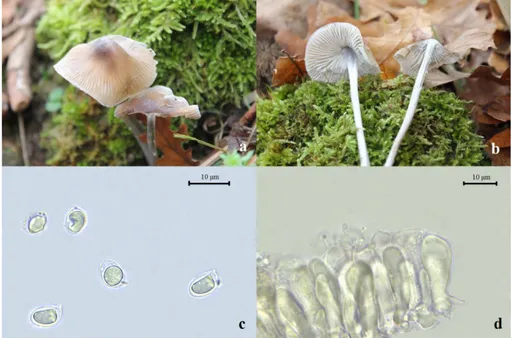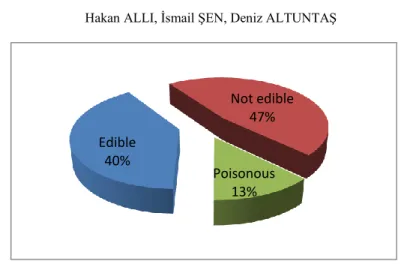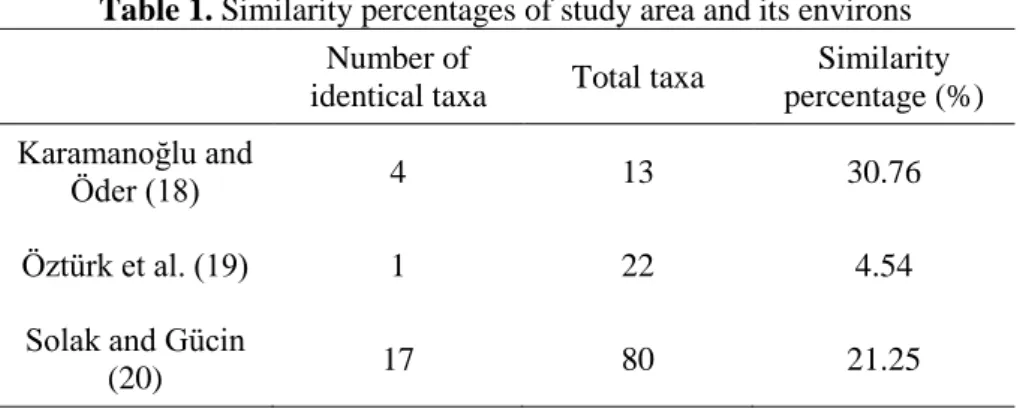DOI: 10.1501/Commuc_0000000183 ISSN 1303-6025
*This study was presented as a oral presentation at 2nd National Mycology Days in İstanbul
© 2016 Ankara University Communications Faculty of Sciences University of Ankara Series C: Biology
MACROFUNGI OF IZNIK PROVINCE
Hakan ALLI, İsmail ŞEN, Deniz ALTUNTAŞ
Muğla Sıtkı Koçman University, Science Faculty, Biology Department, Muğla, Turkey
hakanalli@gmail.com, frapesle@gmail.com,denizaltuntas91@gmail.com
(Received: April 04, 2016; Accepted: June 20, 2016 ) ABSTRACT
In this study, it is aimed to determine macrofungi diversity of İznik province. The fungal specimens were collected between 2013 and 2014 years during field and laboratory studies, 78 macrofungi taxa belonging 30 families and 2 classis were determined. Among these taxa, Mycena erubescens was identified at the first time in Turkey and reported as new record for Turkish Mycota.
KEYWORDS: Iznik, macrofungi biodiversity, taxonomy, new record, Mycena erubescens
1. INTRODUCTION
İznik,located South Marmara Region of Turkey, is one of the historical areas and has an importance for Turkish culture and history. Besides of this, İznik province has natural beauty and rich ecological value. The area has rich vegetation due to positive effects of İznik Lake on climatic conditions. Basically, deciduous forests (Quercus frainetto, Q. cerris, Q. petraea,
Castanea sativa, Fagus orientalis, Carpinus betulus and Acer campestre) and
coniferous forests (Pinus nigra and P. brutia) are located in the area (1). These factors show that climatic conditions and vegetations are suitable for mushrooms.
In recent years, several studies have been carried out on biodiversity of Turkish mycota. But, the macrofungi biodiversity of Turkey is not fully determined and scientific studies on macrofungi biodiversity are not carried
out in some areas of Turkey (2, 3, 4, 5, 6, 7). Similarly, İznik is one of these areas in which the macrofungi biodiversity is not determined (8, 9, 10), and additionally, this area is under anthropogenic threats as a consequence of its cultural and agricultural importance. So, we attempted to determine macrofungi biodiversity of the İznik and vicinity of İznik Lake (Figure 1).
Figure 1. İznik province
2. MATERIAL AND METHODS
Specimens of macrofungi were collected from different localities of İznik province and vicinity of İznik Lake during routine field trips in 2013-2014. In the field, morphological and ecological features of specimens were recorded and they photographed in their habitat. The specimens were brought to laboratory with suitable conditions. Microscopic features were examined by using light microscope, and then specimens were identified morphologically using the references of current literature (11, 12, 13, 14, 15, 16, 17).
The identified specimens were deposited at the fungarium of Muğla Sıtkı Koçman University.
3. RESULTS
The taxonomy of taxa are given in accordance with Index Fungorum
(www.indexfungorum.org, accessed date, 01.01.2016). The taxa are listed
with locality features, collection date and accession number.
Ascomycota Caval.- Sm. Diatrypaceae Nitschke
1. Diatrype disciformis (Hoffm.) Fr.
Bayırköy, on beech branches, Fagus orientalis – Pinus nigra mixed forest, 547 m.,13.04.2014, Allı 5429. Not edible.
2. Diatrypella quercina (Pers.) Cooke
Yörükler village, on dead oak branches, hardwood forest, 341 m., 24.11.2013,
Allı 5256. Not edible.
Helvellaceae Fr.
3. Helvella leucomelaena (Pers.) Nannf.
Gürbüzlü, Pinus pinea forest, 425 m., 13.04. 2014, Allı 5436. Poisonous.
Pyronemataceae Corda
4. Scutellinia scutellata (L.) Lambotte
İstanbul Gate of Ottoman Walls, İznik centre, 86 m., 13.04. 2014, Allı 5440. Not edible.
Xylariaceae Tul. & C. Tul.
5. Biscogniauxia nummularia (Bull.) Kuntze
Bayırköy, on beech branches, Fagus orientalis – Pinus nigra mixed forest, 547 m., 13.04.2014, Allı 5427. Not edible.
6. Xylaria carpophila (Pers.) Fr.
Bayırköy, on beech branches, Fagus orientalis – Pinus nigra mixed forest, 547 m., 13.04.2014, Allı 5431. Not edible.
Basidiomycota R.T. Moore Auriculariaceae Fr.
7. Exidia glandulosa (Bull.) Fr.
Bayırköy, on beech branches, Fagus orientalis – Pinus nigra mixed forest, 547 m., 13.04.2014, Allı 5426. Not Edible.
Agaricaceae Chevall.
8. Agaricus bisporus (J.E. Lange) Imbach
Karacasu Delta, in grass, 78 m., 23.11.2013, Allı 5211. Edible. 9. Agaricus macrocarpus F.H. Møller
Yörükler village, in grass, 321m., 24.11.2013, Allı 5249. Edible. 10. Agaricus silvicolae-similis Bohus & Locsmándi
Aydınlar village, mixed conifer forest, 327 m., 23.11.2013, Allı 5216. Edible. 11. Agaricus subfloccosus (J.E. Lange) Hlaváček
Bayırköy village, Fagus orientalis – Pinus nigra mixed forest, 547 m., 24.11.2013, Allı 5299. Edible.
12. Agaricus xanthodermus Genev.
Aydınlar village, mixed conifer forest, 327 m., 23.11.2013, Allı 5219. Poisonous.
13. Bovista nigrescens Pers.
Karacasu Delta, in grass, 78 m., 23.11.2013, Allı 5209. Edible. 14. Cystodermella granulosa (Batsch) Harmaja
Bayırköy village, Fagus orientalis – Pinus nigra mixed forest, 547 m., 24.11.2013, Allı 5294. Not Edible.
15. Lycoperdon perlatum Pers.
Bayırköy village, Fagus orientalis – Pinus nigra mixed forest, 547 m., 24.11.2013, Allı 5280. Edible.
16. Lycoperdon pyriforme Schaeff.
Bayırköy village, on stumps, Fagus orientalis – Pinus nigra mixed forest, 547 m., 24.11.2013, Allı 5280a. Edible.
17. Lycoperdon umbrinum Pers.
Aydınlar village, mixed conifer forest, 327 m., 23.11.2013, Allı 5222. Edible. 18. Macrolepiota excoriata (Schaeff.) Wasser
Karacasu Delta, in grass, 78 m., 23.11.2013, Allı 5206; Yörükler village, in grass, 321m., 24.11.2013, Allı 5251. Edible.
19. Macrolepiota mastoidea (Fr.) Singer
Yörükler village, hardwood forest, 341m., 24.11.2013, Allı 5255; Bayırköy village, Fagus orientalis – Pinus nigra mixed forest, 547 m., 24.11.2013, Allı 5277. Edible.
20. Macrolepiota procera (Scop.) Singer
Bayırköy village, Fagus orientalis – Pinus nigra mixed forest, 547 m., 24.11.2013, Allı 5276; 26.05.2014, Allı 5575. Edible.
Amanitaceae R. Heim ex Pouzar
21. Amanita citrina Pers.
Bayırköy village, Fagus orientalis – Pinus nigra mixed forest, 547 m., 24.11.2013, Allı 5288; Allı 5290. Not edible.
22. Amanita pantherina (DC.) Krombh.
Bayırköy village, Fagus orientalis – Pinus nigra mixed forest, 547 m., 24.11.2013, Allı 5297. Deadly poisonous.
Bankeraceae Donk
23. Hydnellum concrescens (Pers.) Banker
Bayırköy village, Fagus orientalis – Pinus nigra mixed forest, 547 m., 24.11.2013, Allı 5274. Not edible.
Bolbitiaceae Singer
24. Panaeolus fimicola (Pers.) Gillet
Bayırköy village, Fagus orientalis – Pinus nigra mixed forest, 547 m., 24.11.2013, Allı 5279. Not edible.
Cortinariaceae R. Heim ex Pouzar
25. Hebeloma crustuliniforme (Bull.) Quél.
Bayırköy village, Fagus orientalis – Pinus nigra mixed forest, 547 m., 24.11.2013, Allı 5273. Not edible.
26. Hebeloma sinapizans (Paulet) Gillet
Müşgüle village, mixed hardwood – conifer forest, 488 m., 23.11.2013, Allı 5245. Not edible.
Geastraceae Corda
27. Geastrum pectinatum Pers.
Karacasu Delta, in grass, 78 m., 23.11.2013, Allı 5208. Not edible.
Gomphidiaceae Maire ex Jülich
28. Chroogomphus helveticus (Singer) M.M. Moser
Bayırköy village, Fagus orientalis – Pinus nigra mixed forest, 547 m., 24.11.2013, Allı 5268. Edible.
29. Chroogomphus rutilus (Schaeff.) O.K. Mill.
Aydınlar village, mixed conifer forest, 327 m., 23.11.2013, Allı 5220. Edible.
Inocybaceae Jülich
30. Crepidotus caspari Velen.
Müşgüle village, mixed hardwood – conifer forest, 488 m., 23.11.2013, Allı 5233; Bayırköy village, Fagus orientalis – Pinus nigra mixed forest, 547 m., 24.11.2013, Allı 5579. Not edible.
31. Inocybe auricoma (Batsch) Sacc.
Müşgüle village, mixed hardwood – conifer forest, 488 m., 23.11.2013, Allı 5242. Not edible.
32. Inocybe geophylla (Bull.) P. Kumm.
Bayırköy village, Fagus orientalis – Pinus nigra mixed forest, 547 m., 24.11.2013, Allı 5289. Poisonous.
33. Inocybe mixtilis (Britzelm.) Sacc.
Bayırköy village, Fagus orientalis – Pinus nigra mixed forest, 547 m., 24.11.2013, Allı 5284. Poisonous.
34. Inocybe queletii Konrad
Bayırköy village, Fagus orientalis – Pinus nigra mixed forest, 547 m., 24.11.2013, Allı 5269. Poisonous.
35. Inocybe whitei (Berk. & Broome) Sacc.
Bayırköy village, Fagus orientalis – Pinus nigra mixed forest, 547 m., 24.11.2013, Allı 5281. Poisonous.
Lyophyllaceae Jülich
36. Lyophyllum connatum (Schumach.) Singer
Göllüce village, hardwood forest, 92 m., 23.11.2013, Allı 5231. Not edible.
Marasmiaceae Roze ex Kühner
37. Marasmius oreades (Bolton) Fr.
Bayırköy village, Fagus orientalis – Pinus nigra mixed forest, 547 m., 24.11.2013, Allı 5301. Edible.
Mycenaceae Roze
38. Hemimycena gracilis (Quél.) Singer
Bayırköy village, Fagus orientalis – Pinus nigra mixed forest, 547 m., 24.11.2013, Allı 5282. Not edible.
39. Mycena erubescens Höhn.
Cap, 8-25 mm, convex to hemispherical when young, later campanulate convex, usually with a obtuse papilla, ocher, pink-brownish to reddish brown or warm brown, darker at the center and paler or whitish towards the margin (Figure 2a).
Lamellea, adnate with a decurrent tooth, ventricose, greyish white, orange red when damaged (Figure 2b).
Stem, 20-50 x 0.5-2 mm, smooth, slightly pubescent at apex, apex white to whitish, increasingly brownish towards to base (Figure 2b).
Spores, 8-10.3 x 6.7-8.2 μm, smooth, hyaline, broadly ellipsoid, amyloid (Figure 2c).
Basidia, 25-30 × 8 – 11 μm, clavate, with two sterigma (Figure 2d).
Ecological features: It grows at autumn to early winter on mossy trunks of broadleaves trees.
Specimen examined: Yörükler village, on Quercus sp. trunk, 341m., 24.11.2013, Allı 5258. Not edible.
Figure 2. Mycena erubescens, a-b. basidiocarp c. spores, d. basidium Omphalotaceae Bresinsky
40. Omphalotus olearius (DC.) Singer
Yörükler village, hardwood forest, 341m., 24.11.2013, Allı 5257. Poisonous.
Physalacriaceae Corner
Müşgüle village, mixed hardwood – conifer forest, 488 m., 23.11.2013, Allı 5239. Not edible.
42. Armillaria cepistipes Velen.
Müşgüle village, mixed hardwood – conifer forest, 488 m., 23.11.2013, Allı 5236. Not edible.
43. Armillaria mellea (Vahl) P. Kumm.
Elbeyli crossroad, 91 m., 23.11.2013, Allı 5214; Müşgüle village, mixed hardwood – conifer forest, 488 m., 23.11.2013, Allı 5234. Not edible.
44. Hymenopellis radicata (Relhan) R.H. Petersen
Bayırköy village, Fagus orientalis – Pinus nigra mixed forest, 547 m., 24.11.2013, Allı 5578. Not edible.
Pleurotaceae Kühner
45. Hohenbuehelia petaloides (Bull.) Schulzer
Yörükler village, hardwood forest, 341m., 24.11.2013, Allı 5260. Edible. 46. Pleurotus ostreatus (Jacq.) P. Kumm.
Bayırköy village, on Populus sp., 547 m., 24.11.2013, Allı 5302. Edible.
Polyporaceae Fr. ex Corda
47. Polyporus arcularius (Batsch) Fr.
Bayırköy village, Fagus orientalis – Pinus nigra mixed forest, 547 m., 24.11.2013, Allı 5421. Not edible.
48. Trametes trogii Berk.
İstanbul Gate of Ottoman Walls, İznik centre, on Platanus orientalis trunk, 86 m., 13.04.2014, Allı 5441; Yörükler village, hardwood forest, 341m., 26.05.2014, Allı 5584. Not edible.
49. Trametes versicolor (L.) Lloyd
Göllüce, on Quercus sp., 92 m., 01.06.2013, Allı 4974. Not edible. 50. Trichaptum fuscoviolaceum (Ehrenb.) Ryvarden
Aydınlar village, mixed conifer forest, 327 m., 23.11.2013, Allı 5218. Not edible.
Psathyrellaceae Vilgalys, Moncalvo & Redhead
51. Coprinopsis marcescibilis (Britzelm.) Örstadius & E. Larss.
Göllüce village, hardwood forest, 92 m., 23.11.2013, Allı 5226; Yörükler village, in grass, 321m., 24.11.2013, Allı 5252. Not edible.
52. Coprinopsis picacea (Bull.) Redhead
Yörükler village, in grass, 341m., 24.11.2013, Allı 5254. Not edible. 53. Coprinopsis radiata (Bolton) Redhead
Göllüce village, hardwood forest, 92 m., 23.11.2013, Allı 5227. Not edible. 54. Psathyrella candolleana (Fr.) Maire
Göllüce village, on Quercus sp., 2 m., 23.11.2013, Allı 5224. Edible.
Pluteaceae Kotl. & Pouzar
55. Volvariella volvacea (Bull.) Singer
Göllüce village, hardwood forest, 23.11.2013, 92m., Allı 5223, Allı 5225; Yörükler village, in grass, 321m., 24.11.2013, Allı 5250. Edible.
Rhizopogonaceae Gäum. & C.W. Dodge
56. Rhizopogon roseolus (Corda) Th. Fr.
Bayırköy village, Fagus orientalis – Pinus nigra mixed forest, 547 m., 24.11.2013, Allı 5267. Edible.
Russulaceae Lotsy
57. Lactarius chrysorrheus Fr.
Müşgüle village, mixed hardwood – conifer forest, 488 m., 23.11.2013, Allı 5241. Poisonous.
58. Lactarius deliciosus (L.) Gray
Aydınlar village, mixed conifer forest, 327 m., 23.11.2013, Allı 5217; Müşgüle village, mixed hardwood – conifer forest, 488 m., 23.11.2013, Allı 5240; Bayırköy village, Fagus orientalis – Pinus nigra mixed forest, 547 m., 24.11.2013, Allı 5261; Allı 5278. Edible.
59. Lactarius quieticolor Romagn.
Bayırköy village, Fagus orientalis – Pinus nigra mixed forest, 547 m., 24.11.2013, Allı 5291. Edible.
60. Lactarius sanguifluus (Paulet) Fr.
Bayırköy village, Fagus orientalis – Pinus nigra mixed forest, 547 m., 24.11.2013, Allı 5300. Edible.
61. Lactarius semisanguifluus R. Heim & Leclair
Bayırköy village, Fagus orientalis – Pinus nigra mixed forest, 547 m., 24.11.2013, Allı 5262. Edible.
62. Russula delica Fr.
Bayırköy village, Fagus orientalis – Pinus nigra mixed forest, 547 m., 24.11.2013, Allı 5263. Edible.
Schizophyllaceae Quél.
63. Schizophyllum commune Fr.
Bayırköy village, Fagus orientalis – Pinus nigra mixed forest, 547 m., 13.04.2014, Allı 5425; İstanbul Gate of Ottoman Walls, İznik centre, on
Platanus orientalis, 86 m., 13.04.2014, Allı 5442. Not edible.
Stereaceae Pilát
64. Stereum hirsutum (Willd.) Pers.
Bayırköy village, Fagus orientalis – Pinus nigra mixed forest, 547 m., 13.04.2014, Allı 5419. Not edible.
Strophariaceae Singer & A.H. Sm.
65. Stropharia caerulea Kreisel
Bayırköy village, Fagus orientalis – Pinus nigra mixed forest, 547 m., 24.11.2013, Allı 5285. Not edible.
66. Stropharia coronilla (Bull.) Quél.
Yörükler village, in grass, 321m., 24.11.2013, Allı 5248. Edible.
Suillaceae Besl & Bresinsky
67. Suillus collinitus (Fr.) Kuntze
Aydınlar village, mixed conifer forest, 327 m., 23.11.2013, Allı 5221; Müşgüle village, mixed hardwood – conifer forest, 488 m., 23.11.2013, Allı 5238; Bayırköy village, Fagus orientalis – Pinus nigra mixed forest, 547 m., 24.11.2013, Allı 5265. Edible.
Tricholomataceae R. Heim ex Pouzar
68. Clitocybe metachroa (Fr.) P. Kumm.
Bayırköy village, Fagus orientalis – Pinus nigra mixed forest, 547 m., 24.11.2013, Allı 5295. Not edible.
69. Clitocybe nebularis (Batsch) P. Kumm.
Bayırköy village, Fagus orientalis – Pinus nigra mixed forest, 547 m., 24.11.2013, Allı 5287. Not edible.
70. Infundibulicybe geotropa (Bull.) Harmaja
Bayırköy village, Fagus orientalis – Pinus nigra mixed forest, 547 m., 24.11.2013, Allı 5286. Edible.
71. Lepista nuda (Bull.) Cooke
Göllüce village, hardwood forest, 92 m., 23.11.2013, Allı 5229. Edible. 72. Lepista personata (Fr.) Cooke
Bayırköy village, Fagus orientalis – Pinus nigra mixed forest, 547 m., 24.11.2013, Allı 5270. Edible.
73. Melanoleuca iris Kühner
Karacasu Delta, in grass – lawn, 78 m., 23.11.2013, Allı 5207. Edible. 74. Tricholoma fracticum (Britzelm.) Kreisel
Bayırköy village, Fagus orientalis – Pinus nigra mixed forest, 547 m., 24.11.2013, Allı 5272. Not edible.
75. Tricholoma sciodes (Pers.) C. Martín
Müşgüle village, mixed hardwood – conifer forest, 488 m., 23.11.2013, Allı 5237. Not edible.
76. Tricholoma terreum (Schaeff.) P. Kumm.
Bayırköy village, Fagus orientalis – Pinus nigra mixed forest, 547 m., 24.11.2013, Allı 5264. Edible.
Tubariaceae Vizzini
77. Tubaria furfuracea (Pers.) Gillet
Göllüce village, hardwood forest, 92 m., 23.11.2013, Allı 5228; Allı 5230; Bayırköy village, Fagus orientalis – Pinus nigra mixed forest, 547 m., 24.11.2013, Allı 5283. Not edible.
78. Tubaria romagnesiana Arnolds
Yörükler village, in grass, 321m., 24.11.2013, Allı 5246. Not edible.
4. DISCUSSION
As a result of the study, seventy eight macrofungi taxa belonging 30 family and 2 classis were determined in the research area. Among the taxa, 6 of them is belonging Ascomycota (Diatrypaceae 2, Helvellaceae 1, Pyronemataceae 1, Xylariaceae 2), and 72 of them is Basidiomycota (Auriculariaceae 1,
Agaricaceae 13, Amanitaceae 2, Bankeraceae 1, Bolbitiaceae 1, Cortinariaceae 2, Geastraceae 1, Gomphidiaceae 2, Inocybaceae 6, Lyophyllaceae 1, Marasmiaceae 1, Mycenaceae 2, Omphalotaceae 1, Physalacriaceae 4, Pleurotaceae 2, Polyporaceae 4, Psathyrellaceae 4, Pluteaceae 1, Rhizopogonaceae 1, Russulaceae 6, Schizophyllaceae 1, Stereaceae 1, Strophariaceae 2, Suillaceae 1, Tricholomataceae 9, Tubariaceae 2). Additionally, Mycena erubescens was recorded at the first
time in Turkey, and reported as new record for Turkish mycota. Before this study, 59 members of the genus Mycena were reported in Turkey (8, 9, 10), and Mycena erubescens is 60th member of this genus.
While 31 taxa are edible, 36 of them are inedible. Similarly, 10 taxa are poisonous (Figure 3). Although 31 taxa are edible, only 4 taxa (Lactarius
deliciosus, L. queticolor, L. sanguifluus and L. semisanguifluus) are known by
Figure 3. Edibility of taxa
Some studies on macrofungi had been carried out at Bursa. 13 taxa from vicinity of Uludağ and its environs (18), and 22 taxa from İnegöl (19) had been reported. Also, Solak and Gücin (20) reported 72 taxa as macrofungi biodiversity of Bursa province, but they didn’t indicate the collecting area of the taxa. According to current literature, this is the first taxonomic study on the macrofungi in the study area, and it is shown that İznik province has rich macrofungi biodiversity. Additionally, it has been shown that 147 macrofungi taxa grow in Bursa province in accordance with this study and the current literature (18, 19, 20).
The similarity percentage of the study and its environs is given in Table 1. The reason of the low similarity percentage of the studies might be ecological features of the study area. İznik Lake softens its environs and increases the moisture levels. So, this situation supports the macrofungi biodiversity of İznik province. But, the climatic conditions are suitable for olive trees and it has been cultivated by local people for economical purposes. So, natural forests are converted as olive farms. This situation is threatened macrofungi generations via destroying of natural habitats of them. For this reason, natural forests should be protected, thus macrofungi biodiversity can be protected in the area. Edible 40% Not edible 47% Poisonous 13%
Table 1. Similarity percentages of study area and its environs
Number of
identical taxa Total taxa
Similarity percentage (%) Karamanoğlu and
Öder (18) 4 13 30.76
Öztürk et al. (19) 1 22 4.54
Solak and Gücin
(20) 17 80 21.25
REFERENCES
[1] P.H. Davis, Flora of Turkey and the East Aegean Islands, Vol. 1-10, (Edinburgh Univ. Press., Edinburgh, 1965-1988).
[2] I. Akata, B. Çetin, M. Işıloğlu, Macrofungal Diversity of Ilgaz Mountain National Park and Its Environs (Turkey), Mycotaxon 113 (2010) 287-290.
[3] H. Servi, I. Akata, B. Çetin, Macrofungal Diversity of Bolu Abant Nature Park (Turkey), Afr. J. Biotechnol., 9 (2010) 3622-3628.
[4] H. Allı, Macrofungi of Kemaliye District (Erzincan), Turk. J. Bot., 35 (2011) 299-308.
[5] I. Akata, Y. Uzun, A. Kaya, Macromycetes Determined in Yomra (Trabzon) District, Turk. J. Bot., 38 (2014) 999-1012.
[6] H. Güngör, M.H. Solak, H. Allı, M. Işıloğlu, E. Kalmış, New Records for Turkey and Contributions to the Macrofungal Diversity of Isparta Province, Turk. J. Bot., 39 (2015) 867-877.
[7] H.H. Doğan, F. Kurt, New Macrofungi Records from Turkey and Macrofungal Diversity of Pozantı-Adana, Turk. J. Bot., 40 (2016) 209-217.
[8] M.H. Solak, M. Işıloğlu, E. Kalmış, H. Allı, Macrofungi of Turkey, Checklist, Vol. I., (Genç Üniversiteliler Ofset, İzmir, 2007).
[9] E. Sesli, C.M. Denchev, Checklist of Myxomycetes, Larger Ascomycetes, and Larger Basidiomycetes in Turkey, Mycotaxon, 106 (2008) 65-67.
[10] M.H. Solak, M. Işıloğlu, E. Kalmış, H. Allı, Macrofungi of Turkey, Checklist, Vol. II., (Üniversiteliler Ofset, İzmir, 2015).
[11] R.W.G. Dennis, British Ascomycetes, (Ganter Verlag, Germany, 1981). [12] J. Breitenbach, F. Kränzlin, Fungi of Switzerland (Vol.1-5), (Verlag
Mycologia, Luzern, 1984-2000).
[13] A. Capelli, Fungi Europaei, Agaricus, (Candusso, Italia, 1984).
[14] M.B. Ellis, J.P. Ellis, Fungi without Gills, (Chapman and Hall, London, 1990).
[15] H. Knudsen, J. Versterhold, Funga Nordica Vol. I., (Nordswamp, Copanhagen, 2008).
[16] H. Knudsen, J. Versterhold, Funga Nordica Vol. II., (Nordswamp, Copanhagen, 2012).
[17] M. Christensen, J. Heilmann-Clausen, The Genus Tricholoma, Fungi of Northern Europe Vol. 4., (Narayana Pres., Denmark, 2013).
[18] K. Karamanoğlu, N. Öder, Bursa İli ve Çevresinde Yetişen Bazı Şapkalı Mantarlar, A.Ü. Eczacılık Fakültesi Mecmuası, 3 (1973) 13-33.
[19] A. Öztürk, K. Demirel, İ.H. Arık, İnegöl (Bursa) Çevresinde Yetişen Zehirli ve Yenen Mantarlar Üzerinde Sistematik, Morfolojik ve Ekolojik İncelemeler, Yüzüncü Yıl Üniversitesi Fen-Edebiyat Fakültesi, Fen Bilimleri Dergisi, 1 (1990) 27-38.
[20] M. Solak, F. Gücin, Bursa Yöresinden Türkiye için Yeni Makrofungus Türleri ve Yörede Belirlenen Diğer Makrofunguslar, Doğa Tr. J. Bot. 16 (1992) 335-346.



